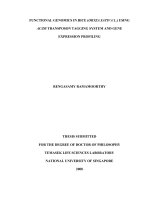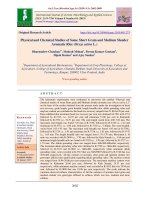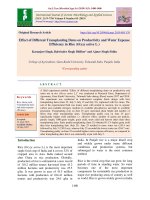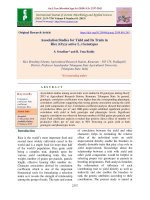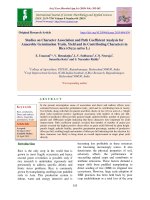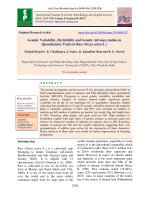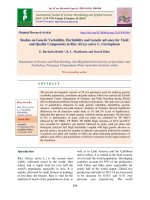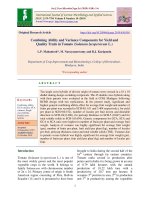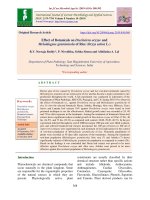Gene action and combining ability for yield and quality traits in rice (Oryza sativa L.) using diallel analysis
Bạn đang xem bản rút gọn của tài liệu. Xem và tải ngay bản đầy đủ của tài liệu tại đây (435.96 KB, 10 trang )
Int.J.Curr.Microbiol.App.Sci (2018) 7(1): 2834-2843
International Journal of Current Microbiology and Applied Sciences
ISSN: 2319-7706 Volume 7 Number 01 (2018)
Journal homepage:
Original Research Article
/>
Gene Action and Combining Ability for Yield and Quality Traits
in Rice (Oryza sativa L.) using Diallel Analysis
K. Rukmini Devi*, V. Venkanna, B. Satish Chandra and Y. Hari
Regional Agricultural Research Station, Mulug road 506007, Warangal, Professor
Jayashankar Telangana State Agricultural University, Telangana, India
*Corresponding author
ABSTRACT
Keywords
Diallel analysis,
Combining ability,
Rice, Quality,
Additive and nonadditive gene
effects
Article Info
Accepted:
20 December 2017
Available Online:
10 January 2018
Eight high yielding rice genotypes along with their twenty eight crosses which effected in
a diallel fashion excluding reciprocals were subjected to combining ability which aimed at
elucidating the genetic system underlying the inheritance of yield and quality traits. The
study revealed predominance of non-additive gene action for most of the yield components
and quality traits except straw yield/plant, which was under the control of additive gene
action. NLR 40024, MTU 1075 and HKR08-62 were identified as good general combiners
for grain yield/plant, panicle length, panicle weight, straw yield/plant, harvest index, head
rice recovery, kernel length after cooking, water uptake and alkali spreading value. The
crosses Kavya × HKR08-62, Gontrabidhan × HKR08-62, Kavya × MTU 1075 have shown
significantly favorable SCA effects for grain yield, yield components and quality traits.
Majority of the crosses with high SCA effects involved with high × low combinations
indicating additive × dominance, dominance × dominance type of gene interactions for
expression of traits. To explore both additive and non-additive type of gene action,
biparental mating among selected crosses or use of selection procedure such as diallel
selective mating may be followed.
Introduction
Rice is the world’s second most important
cereal crop and staple food for more than 60
% of the global population. To meet the food
demand of the growing population and to
achieve food security in the country, the
production levels need to be increased by 2
million tons every year. As there is no scope
to increase the cultivable area the only
alternative is to improve the genetic potential.
Plant breeders continuously refine and
improve genetic traits of new varieties
required. One of the main problems for
improving high yielding varieties is to select
suitable parents and hybrids derived from the
crosses between them. In order to formulate
efficient
breeding
programmes,
for
improvement of yield and quality traits it is
essential to characterize the nature and mode
of gene action. A sound breeding
methodology rests on a correct understanding
of the gene effects involved. The combining
ability analysis provides the information about
the parents for hybridization. Efficient
identification of superior cross combinations
2834
Int.J.Curr.Microbiol.App.Sci (2018) 7(1): 2834-2843
is another issue in hybrid breeding.
Phenotypic selection of promising parental
lines can be performed either based on GCA
and SCA is most important for predicting
hybrid performance based on GCA effects
(Fischer et al., 2008).
Diallel analysis is one of the most powerful
tools for estimating the general combining
ability (GCA) of parents and selection of
desirable parents and crosses with high
specific combining ability (SCA) for
exploitation of heterosis and to get the
knowledge of gene effects and variance
components. Hence the present study was
undertaken to assess the combining ability of
promising eight rice genotypes using half
diallel analysis.
Materials and Methods
The material comprised of eight high yielding,
photoinsensitive and diverse varieties viz.,
Kavya, Gontrabidhan, BPT 5204, R15562577, MTU 1075, WGL 915, NLR 40024 and
HKR08-62 were crossed in diallel fashion
without reciprocals. The 36 entries i.e. 28
crosses and 8 parents were grown in a
randomized block design with two replications
at Regional Agricultural Research Station,
Warangal during Kharif 2016. Single seedling
per hill was transplanted at a spacing of 20
x15 cm between the rows and plants. Each
entry consists of two rows of 3m length. All
the recommended cultural practices were
followed to obtain healthy crop.
Observations were recorded on 10 randomly
selected plants without border effect for
twenty five yield and quality traits except days
to 50 % flowering which was taken on plot
basis, plant height (cm), panicle length (cm),
effective tillers/plant, flag leaf length (cm),
flag leaf width (cm), panicle weight (g),
panicle density, filled grains/panicle, test
weight (g), grain yield/plant (g), straw
yield/plant (g), harvest index, hulling percent,
milling percent, head rice recovery (%), kernel
length
(mm),
kernel
width
(mm),
length/breadth ratio, kernel length after
cooking (mm), kernel width after cooking
(mm), kernel elongation ratio, volume
expansion ratio, water uptake (ml) and alkali
spreading value. Data on hulling and milling
was taken with the help of SATAKE company
make laboratory huller and polisher. Data on
head rice recovery was recorded. Kernel
length and kernel width of 20whole milled
rice were measured by means of dial caliper
and length/breadth ratio was computed as per
Murthy and Govida Swamy (1967).
Kernel elongation ratio was determined by
soaking 5g of whole milled rice in 12 ml
distilled water for 10 minutes and later cooked
for 15 minutes in water bath. Observations on
length and breadth of cooked kernel and
kernel elongation ratio were recorded with the
help of graph sheet to quantify cooking traits.
Volume expansion ratio, water uptake and
alkali spreading value were estimated by
following standard procedures. The combining
ability analysis was carried out as per Griffing
(1956), method-2 (Model-I).
Results and Discussion
Analysis of variance for combining ability
(Table 1) showed significant differences
among 36 genotypes for all the characters
studied. Mean squares due to general
combining ability (GCA) were significant for
all the character except kernel elongation
ratio, whereas specific combining ability
(SCA) were significant for all the yield and
quality traits studied. This suggests
importance of both additive and non-additive
gene effects in the material under study.
Hence any approach that facilitates
simultaneous exploitation of both additive and
non-additive gene effects would be more
desirable for the improvement of the traits.
2835
Int.J.Curr.Microbiol.App.Sci (2018) 7(1): 2834-2843
The estimates of the components due to GCA
and SCA effects and their ratio showed that
non additive gene effect was higher than
additive effect for all the yield and quality
characters except straw yield/plant for which
additive component may be predominant.
Occurrence of both additive and non-additive
gene effects with predominance of nonadditive gene action for yield and quality traits
in rice were reported by Rukmini Devi, et al.,
(2014 a), Verma and Srivastava (2004) and
Vanaja, et al., (2003). also found that GCA
and SCA effects were highly significant for
days to 50% flowering, plant height, effective
tillers, panicle length, filled grains per panicle
and test weight, while Ram kishor et al.,
(2017) for plant height, effective tillers, flag
leaf length, flag leaf width, panicle length, test
weight and grain yield per plant indicating
prevalence of additive and non-additive
effects in the inheritance of traits, as well as
greater importance of non-additive gene
action.
The GCA effect which determines the average
performance of a parent in crosses and is an
estimate of its F1 breeding value determined
for each parent (Table 2). The selection of
suitable parents for hybridization is one of the
most important steps in a breeding programme
to get best combination in F1 hybrids or
segregating generation. The GCA is controlled
by additive genes which is fixable. It provides
information on the choice of parents in terms
of expected performance of their progenies.
The genotype NLR 40024 was found to be
good general combiner and possessed high
GCA effects for important yield components
like panicle length, panicle weight, panicle
density, test weight, straw yield/plant, harvest
index, head rice recovery, kernel length after
cooking, water uptake and alkali spreading
value. Another culture HKR08-62 was quite
promising for effective tillers, flag leaf length
(short flag leaf), panicle weight and kernel
width after cooking (negative direction) and
R1556-2577 for days to 50% flowering
(earliness), panicle length and kernel length,
while MTU 1075 for grain yield/plant, filled
grains per panicle, panicle length, kernel
length, kernel width and kernel width after
cooking
in
desired
direction
and
length/breadth ratio. The genotype WGL 915
was good for effective tillers, straw yield per
plant, harvest index and head rice recovery.
The negative estimates of GCA effect are
desirable for earliness, plant height, flag leaf
length and flag leaf width. Among the parents
studied BPT 5204 proved to be good combiner
for earliness, short stature, flag leaf length,
flag leaf width and panicle density. For
effective tillers HKR08-62 and WGL 915; for
panicle length, panicle weight and panicle
density R15556-2577, MTU 1075 and NLR
40024; for filled grains per panicle Kavya and
MTU 1075; for test weight all the parents
except BPT5204 exhibited significant GCA.
For quality traits, WGL 915, Kavya and NLR
40024 for milling percent and NLR40024,
WGL 915 and HKR08-62 recorded significant
GCA values for head rice recovery. None of
the parents were good general combiners for
all the desirable traits studied.
Specific combining ability is the deviation
from the performance predicted on the basis of
general combining ability of the parents and it
is due to non-additive gene effect. The
usefulness of a particular cross in exploiting
heterosis is judged by specific combining
ability effects (Table 3). It is an important
criterion for the evaluation of hybrids.
Significant SCA effect for grain yield/plant
were recorded by nine hybrids Kavya ×
HKR08-62, Gontrabidhan × HKR08-62,
Kavya × MTU 1075, BPT 5204 × R15562577, kavya × BPT 5204, Gontrabidhan ×
MTU 1075, BPT 5204 × WGL 915, R15562577 × HKR08-62 and WGL 915 × HKR0862.
2836
Int.J.Curr.Microbiol.App.Sci (2018) 7(1): 2834-2843
Table.1 Analysis of variance for combining ability for yield, yield components and quality traits in 8×8 diallel analysis using
Griffing’s method-2
Source of variation
df
Replication
Genotypes
GCA
SCA
Parents
Crosses
Parents vs Hybrids
Error
2
GCA
2
SCA
2
GCA /
2
SCA
1
35
7
28
7
27
1
35
Days to
50%
flowering
1.68
83.3**
75.5**
33.2**
68.2**
83.4**
186.0**
2.22
7.44
32.11
0.231
Plant
height
(cm)
6.54
215.3**
96.4**
110.4**
349.4**
156.1**
873.2**
10.59
9.10
105.2
0.09
Effective
tillers
0.125
14.66**
4.38**
8.067**
9.96**
16.27**
4.06
2.01
0.337
7.06
0.047
Panicle
length(
cm)
0.306
11.72**
6.90**
5.59**
18.2**
9.38**
29.6**
0.78
0.65
5.21
0.125
Flag leaf
length
(cm)
1.003
30.48**
22.4**
13.4**
38.99**
27.83**
42.0**
1.54
2.16
12.7
0.17
Flag leaf
width
(cm)
0.13
0.12**
0.07**
0.06**
0.11**
0.12**
0.00
0.02
0.006
0.046
0.131
Panicle
weight (g)
Panicle
density
0.69
2.99**
1.32**
1.54**
2.64**
3.17**
0.706**
0.05
0.129
1.517
0.09
0.016
9.32**
4.83**
4.62**
14.22**
8.16**
6.44**
0.21
0.473
4.51
0.1048
Filled
grains per
panicle
4.0134
6423.99**
2988.90**
3267.77**
8730.96**
6053.26**
285.01
140.699
291.855
3197.42
0.091
Test
weight (g)
0.073
22.72**
13.63**
10.79**
29.33**
17.65**
113.33**
0.2900
1.348
10.64
0.126
Grain
yield ×
plant (g)
18.0
119.81**
56.08**
60.86**
108.30**
126.7**
13.76
4.26
5.39
58.73
0.091
Straw yield
× plant (g)
HI
0.18
162.93**
35.98**
92.38**
6.11**
3.29**
89.78**
0.036
169.87
158.06
246.03
0.00005
0.016**
0.0002**
0.009**
0.013**
0.015**
0.035**
0.00112
0.00022
0.00863
0.025
Table.1 Contd….
Sourceof variation
df
Hulling
percent
Milling
percent
Head rice
recovery
Kernel
length
(mm)
Kernel
width
(mm)
L×B ratio
Kernel
length after
cooking
Replication
Genotype
GCA
SCA
Parents
Hybrids
Parents vs Hybrids
Error
2
GCA
2
SCA
2
GCA /
2
SCA
1
35
7
28
7
27
1
35
0.029
15.410**
9.337**
7.297**
24.882**
12.195**
35.912**
2.239
0.822
6.177
0.133
7.157
89.768**
63.054**
40.341**
197.037**
56.935**
225.373**
2.845
6.163
38.92
0.158
1.272
185.564**
116.330**
86.895**
273.590**
167.692**
51.920**
5.140
11.376
84.32
0.135
0.003
0.318**
0.140**
0.164**
0.036**
0.025**
0.000
0.006
0.0125
0.149
0.084
0.009
0.026**
0.012**
0.013**
0.313**
0.104**
0.123**
0.011
0.00
0.0104
0.0862
0.014
0.146**
0.092**
0.068**
0.712**
0.224**
0.111
0.029
0.0086
0.0629
0.1369
0.110
0.513**
0.237**
0.261**
0.662**
0.491**
0.070
0.076
0.0199
0.223
0.089
*, ** Significant at 5% and 1% level, respectively.
2837
Kernel
width
after
cooking
0.011
0.076**
0.051**
0.035**
0.027
0.090**
0.034
0.018
0.0042
0.0259
0.163
Kernel
elongation
ratio
Volume
e×pansion
ratio
Water
uptake
Alkali
spreading
value
0.003
0.009**
0.003
0.005**
0.009
0.010**
0.000
0.004
0.000006
0.00307
0.0204
0.005
0.191**
0.074*
0.101**
0.088
0.218**
0.192
0.057
0.0045
0.0723
0.0627
4851.125**
4177.068**
2668.791**
1943.470**
5919.348**
3662.572**
2872.509**
186.954
257.5
1849.9
0.139
0.376
3.386**
1.901**
1.641**
3.345**
3.497**
0.660*
0.152
0.182
1.565
0.117
Int.J.Curr.Microbiol.App.Sci (2018) 7(1): 2834-2843
Table.2 General combining ability of the parents for yield and quality traits
Parents
Days to 50%
flowering
Plant
height
(cm)
Effectiv
e tillers
Panicle
length
(cm)
Kavya
-1.438**
0.149
-0.188
-0.114
Flag
leaf
length
(cm)
-0.539*
Panicle
weight(g)
Panicle
density
Filled grains
per panicle
Test
weight(g)
Grain
yield×plant
(g)
Straw
yield×plant
(g)
HI
0.175**
1.276**
27.213**
1.779**
-2.38**
-1.05*
-0.017*
-1.124**
0.221
Flag
leaf
width
(cm)
0.119*
*
-0.066*
0.019
BPT 5204
Gontrabidha
n
R1556-2577
MTU 1075
-2.688**
-2.088**
-3.551**
1.384*
0.513
-0.338
-0.814**
0.621**
0.050
0.159**
0.295**
0.149
1.163
4.113
0.099
0.306*
-1.025*
3.12**
-3.4**
-0.63
-0.023**
-0.006
-3.088**
2.663**
1.129
4.179**
-0.788*
-0.938**
1.071**
0.656**
0.861**
1.856**
0.044
0.039
0.376**
0.234**
0.359**
0.536**
1.813
17.113**
1.411**
0.606**
1.82**
2.055**
-0.53
0.275
-0.004
-0.003
WGL 915
NLR 40024
HKR08-62
1.313**
1.217**
4.713**
-3.606**
3.409**
-3.091**
0.713*
0.263
0.763*
-1.194**
0.496*
-0.724**
-1.189**
2.016**
-2.104**
-0.036
0.039
0.156*
*
0.398**
0.191**
0.689**
0.054
0.649**
0.899**
-12.988**
-11.138**
-27.288**
0.884**
1.451**
1.014**
-2.76**
2.61*
-0.92*
1.350*
2.995**
0.99
0.021**
0.022**
0.010
*, ** Significant at 5% and 1% level, respectively.
Table.2 Contd…..
Parents
Hulling
percent
Milling
percent
Head rice
recovery
(%)
Kernel
length
(mm)
Kernel
width
(mm)
length×bre
adth ratio
Kernel
length
after
cooking
Kernel
width after
cooking
Elongation
ratio
Volume
expansion
ratio
Water
uptake
Alkali
spreading
value
Kavya
1.193**
2.625**
2.099**
-0.071
-0.034*
0.053*
-0.183**
-0.065*
-0.022
-0.053
-29.238**
-0.683**
BPT 5204
Gontrabidhan
-0.603
-0.194
-1.207**
0.031
-2.389**
-4.253**
-0.189**
0.004
-0.005
0.033*
-0.072**
-0.082**
-0.133*
0.052
-0.035
0.093**
0.016
0.012
-0.063
-0.083
4.413
16.413**
0.008
0.498**
R1556-2577
0.987**
-0.895*
-2.626**
0.139**
-0.015
0.093**
0.172**
-0.023
0.002
-0.053
7.863**
0.098
MTU 1075
-1.892**
-5.001**
-3.037**
0.093*
-0.047**
0.162**
-0.031
-0060*
-0.023
0.098
-20.288**
-0.443**
WGL 915
0.381
2.822**
2.923**
-0.089*
0.027
-0.112**
-0.142*
0.080**
-0.010
0.023
0.413
0.383**
NLR 40024
-0.006
1.401**
4.649**
-0.144**
0.053**
0.002
0.248**
0.080**
0.018
0.158**
14.813**
0.428**
HKR08-62
0.134
0.223
2.637**
-0.029
-0.011
-0.042
0.016
-0.070*
0.007
-0.028
5.613
-0.288**
2838
Int.J.Curr.Microbiol.App.Sci (2018) 7(1): 2834-2843
Table.3 Specific combining ability effects of hybrids for yield, yield components and quality traits in rice
Hybrid
Days to 50%
Plant
Effective
Panicle
Flag leaf
Flag leaf
Panicle
Panicle
Filled grains
Test
Grain
Straw
flowering
height(cm)
tillers
length(cm)
length(cm)
width(cm)
weight(g)
density
per panicle
weight(g)
yield×plant(g)
yield×plant(g)
Kavya× BPT5204
3.194**
2.768
0.856
1.040
0.592
0.141
0.805**
1.368**
46.528**
0.168
7.551**
2.183
Kavya× Gontrabidhan
-5.406**
-10.167**
-1.294
-1.595**
-0.353
-0.094
-0.958**
-1.987**
-60.422**
1.257**
-10.444**
-2.287
-0.019
Kavya×R1556-2577
-2.406*
-0.512
-0.344
-0.445
-1.143
-0.019
-0.236
-0.177**
-4.122
-0.548
-1.644
-5.587**
-0.036
Kavya×MTU1075
-0.556
2.338
-2.194*
1.120
1.662
0.086
1.117**
-0.372
-21.422**
1.707**
9.231**
4.708**
-0.017
Kavya×WGL915
-8.306**
-7.677**
-1.844
-0.830
-1.543
-0.089
-0.482**
-0.032
-15.822*
-1.403**
1.936
-7.767**
-0.006
Kavya×NLR40024
2.294*
-0.792
-0.894
1.080
0.252
0.136
-0.181
-0.437
2.828
1.562**
0.686
-2.812
-0.082**
Kavya×HKR08-62
1.294
1.308
4.606**
0.350
3.022**
0.031
1.104**
2.963**
77.478**
-0.523
14.096**
3.093
0.035
BPT5204×Gontrabidhan
-1.156
-9.367**
0.006
-0.645
-0.118
-0.059
0.002
2.943**
57.625**
-4.573**
3.011*
0.863
-0.002
BPT5204× R1556-2577
8.344**
16.488**
-3.044**
1.855**
8.992**
0.516**
1.664**
1.553**
57.428**
0.273
8.811**
16.363**
0.150**
BPT5204×MTU1075
-7.806**
-14.762**
-0.394
-3.180**
-6.353**
-0.029
-1.228**
-0.292
-36.372**
-0.623
-7.714**
-7.342**
-0.075**
BPT5204× WGL915
1.944*
8.823**
5.456**
3.770**
0.842
0.246**
1.343**
-1.302**
1.228
3.467**
5.591**
5.283**
0.035
BPT5204× NLR40024
1.044
-0.692
-1.594
-1.820**
-3.563**
-0.429**
-0.921**
-0.957**
-38.122**
-0.268
2.241
-5.262**
-0.056*
BPT5204× HKR08-62
-1.456
9.808**
-3.594**
0.700
1.557
-0.034
0.614**
1.493**
40.528**
-1.003**
-15.299**
-8.357**
-0.093**
Gontrabidhan× R1556-2577
1.244
-7.647**
-0.194
-3.480**
-2.353**
-.369**
-1.499**
-0.152
-37.022**
-3.383**
-14.284**
-11.407**
-0.117**
Gontrabidhan× MTU1075
5.094**
5.603*
-0.544
0.435
-2.848**
-0.114
0.193
-0.247
0.822
-0.728*
6.091**
1.188
0.018
Gontrabidhan× WGL915
1.344
-5.362*
-4.194**
-1.215*
0.847
0.361**
-1.250**
-1.857**
-54.222**
1.062**
-5.004**
23.613**
0.228**
Gontrabidhan× NLR40024
-4.556**
-2.227
1.256
2.545**
-0.308
0.136
1.171**
-1.012**
-10.072
5.277**
1.146
-11.032**
-0.103**
Gontrabidhan× HKR08-62
-8.056**
-10.927**
4.256**
-1.185*
-1.338
0.031
-1.074**
-2.362**
-67.422**
0.442
10.156**
-3.727
-0.035
R1556-2577× MTU1075
-3.406**
2.958
-2.094*
0.985
0.112
-0.039
2.116**
2.113**
69.478**
2.467**
-6.409**
-4.812**
-0.040
R1556-2577× WGL915
-2.656**
-7.057**
-1.244
-0.565
-2.843**
-0.064
-0.398**
1.803**
40.578**
-4.643**
-5.004**
-9.987**
-0.109**
R1556-2577× NLR40024
-2.556*
5.928**
-1.294
1.145
-0.048
0.061
1.348**
2.248**
69.228**
-2.428**
-4.554**
-6.432**
-0.060**
R1556-2577 × HKR08-62
-5.506**
6.028**
-0.294
1.265*
0.472
0.206*
0.638**
0.202
2.878
1.437*
3.656**
-2.927*
-0.028
MTU1075× WGL915
-8.306**
-11.407**
1.906*
-1.450**
-7.238**
-0.459**
-1.170**
-2.842**
-75.222**
-0.138
0.671
-11.642**
-0.115**
MTU1075× NLR40024
0.794
1.578
4.356**
-2.440**
5.757**
0.216*
-.254
4.653**
89.928**
-7.673**
-2.179
8.263**
0.099**
MTU1075× HKR08-62
8.294**
-8.422**
0.856
-2.670**
0.677
0.011
-1.089**
0.553
9.922
-5.358**
-8.219**
11.468**
0.122**
WGL915× NLR40024
-4.956**
-9.837**
3.206**
-1.890**
0.398
-0.109
-1.058**
-2.157**
-61.472**
0.717*
-2.474
-5.862**
-0.060**
WGL915× HKR08-62
13.044**
10.763**
-0.794
2.880**
1.322
0.186*
-0.078
-0.307
18.178*
-2.368**
2.736*
11.293**
0.107**
NLR40024× HKR08-62
-5.356**
-19.652**
2.656**
-5.360**
-7.083**
-0.439**
-1.722**
-0.512
-51.672**
-2.953**
-0.914
-8.752**
-0.084**
2839
HI
0.013
Int.J.Curr.Microbiol.App.Sci (2018) 7(1): 2834-2843
Table.3 Contd……
Hybrid
Hulling
percent
Milling
percent
0.835
0.716
Kavya×BPT5204
-2.534*
-14.600**
Kavya×Gontrabidhan
1.626
7.746**
Kavya×R1556-2577
-0.756
2.993**
Kavya×MTU1075
-1.0828
-2.090
Kavya×WGL915
1.738
0.670
Kavya×NLR40024
0.319
1.028
Kavya×HKR08-62
-1.179
0.592
BPT5204×Gontrabidhan
2.081*
2.618*
BPT5204× R1556-2577
5.099**
11.865**
BPT5204×MTU1075
2.767**
0.142
BPT5204× WGL915
-0.387
-2.318*
BPT5204× NLR40024
1.204
-13.800**
BPT5204× HKR08-62
1.712
2.160
Gontrabidhan× R1556-2577
3.170**
0.307
Gontrabidhan× MTU1075
1.078
4.884**
Gontrabidhan× WGL915
-2.556*
0.544
Gontrabidhan× NLR40024
-0.115
3.362**
Gontrabidhan× HKR08-62
-6.690**
-1.387
R1556-2577× MTU1075
-0.042
2.130
R1556-2577× WGL915
1.684
-0.150
R1556-2577× NLR40024
0.445
4.508**
R1556-2577 × HKR08-62
-0.804
0.661
MTU1075× WGL915
4.122**
9.297**
MTU1075× NLR40024
0.903
4.935**
MTU1075× HKR08-62
-3.530**
-3.206**
WGL915× NLR40024
0.271
1.132
WGL915× HKR08-62
1.937
1.732
NLR40024× HKR08-62
*, ** Significant at 5% and 1% level, respectively.
Head
rice
recover
y(%)
Kernel
length(m
m)
Kernel
width(
mm)
length
×brea
dth
ratio
Kernel
length
after
cooking
Kernel
width
after
cooking
Elongati
on ratio
Volume
e×pansi
on ratio
Water
uptake
Alkali
spreadin
g value
-10.149**
0.029*
0.128*
-0.222**
-0.271
0.018
-0.071
0.112
-11.717
-0.017
-11.785**
0.356**
0.294**
-0.262**
1.094**
0.298**
0.128**
0.282
76.283**
1.393**
6.768**
-0.034
-0.022
0.013
0.074
-0.038
0.028
0.152
8.833
0.593*
7.039**
0.542**
0.049
0.144*
0.477*
0.125
-0.017
0.002
15.483
0.233
-0.421
-0.287*
-0.099
0.018
-0.412*
-0.190*
-0.025
-0.423**
-42.717**
0.008
-0.247
0.386**
-0.096
0.404**
0.048
-0.140
-0.068
-0.058
2.883
-1.337**
1.825
-0.131
0.104*
-0.202**
-0.370*
0.035
-0.042
0.027
-22.917*
-0.622*
0.903
-0.291*
-0.119*
0.063
-0.381*
-0.183*
-0.020
0.092
-64.867**
-0.297
9.936**
0.284*
0.009
0.088
-0.051
-0.093
-0.070
-0.038
-2.817
-1.397**
4.087**
-0.480**
0.051
-0.381**
-0.399*
-0.105
0.020
0.512**
-0.667
-0.157
-0.753
0.642**
-0.163**
0.743**
0.018
0.055
-0.123*
-0.213
-18.867*
0.116
-8.179**
-0.191
-0.024
-0.121
0.298
0.005
0.099*
-0.048
24.233**
0.273
-15.407**
0.022
0.050
-0.077
-0.020
-0.070
-0.010
0.037
-41.567**
-1.112**
7.560**
-0.364**
-0.049
-0.102
-0.561**
0.005
-0.036
0.082
-50.817**
-1.087**
2.311
-0.158
0.082
-0.221**
-0.333
-0.133
-0.036
-0.268
-27.167**
-0.540*
0.671
0.459**
0.024
0.253**
0.028
0.478**
-0.084
-0.2293
34.633**
2.278**
-3.135*
0.306**
0.047
0.039
0.513**
-0.023
0.028
0.922**
10.733
-0.817**
4.497**
0.369**
-0.013
-0.017
0.170
-0.23
-0.041
-0.243
18.933*
2.248**
-1.506
-0.103
0.051
-0.096
0.347
-0.018
0.084*
0.002
-14.117
-0.147
-4.656**
-0.061
-0.138**
0.028
-0.067
-0.083
-0.004
0.177
-12.3127
-0.972**
-6.942**
-0.079
-0.074
0.114
0.018
0.018
0.018
-0.208
0.783
-0.017
-1.750
-0.026
0.025
0.008
-0.100
0.068
-0.011
-0.273
-50.017**
0.198
-13.305**
-0.115
-0.016
-0.041
0.061
-0.270**
0.036
0.377*
-16.667
-0.532*
15.509**
-0.493**
-0.033
-0.261**
-0.554**
-0.145
-0.013
-0.508**
-35.067**
-0.577*
14.421**
-0.690**
-0.138**
-0.111
-0.797**
-0.045
-0.011
0.177
-16.867
-0.862**
-3.351*
-0.071
0.224**
-0.331***
0.807**
0.390**
0.170**
0.517**
103.233
2.598**
2.061
0.172
-0.032
0.063
0.719**
-0.110
0.101*
-0.0048
37.433**
1.213
16.695**
-0.581**
-0.088
-0.151*
-0.826**
0.135
-0.037
-0.083
-39.468**
0.768
2840
Int.J.Curr.Microbiol.App.Sci (2018) 7(1): 2834-2843
Among the nine hybrids, five hybrids have at
least one parent with significant positive GCA
effect. The hybrid Kavya × HKR08-62
showed significant positive SCA effects for
effective tillers per plant, panicle weight,
panicle density and filled grains per panicle.
The hybrid Gontrabidan × HKR08-62 for
days to 50% flowering and plant height in
desired direction, effective tillers per plant,
milling percent, head rice recovery, kernel
length, water uptake and alkali spreading
value, while Kavya × MTU 1075 and BPT
5204 × MTU 1075 and BPT 5204 × WGL
915 recorded significant positive effects in
desired direction for six characters each. BPT
5204 × WGL 915 was registered high
significant effects for effective tillers, panicle
length, panicle weight, test weight, straw
yield / plant, hulling percent, kernel length
and kernel width in desired direction and
length / breadth ratio. However, no cross
combined all values in a desirable direction
indicating the necessity of previous breeding
value of the parents to combine desirable
SCA effects in a single hybrid. The
superiority of the cross may be due to
complementary and duplicate type of gene
interactions. Majority of the crosses with high
SCA effects involved with high × low
combinations
indicating
additive
×
dominance, dominance × dominance type of
gene interactions for expression of traits.
Similar results were earlier reported by
Rukmini Devi et al., (2017 b), Vanaja et al.,
(2003) and Gnanamalar and Vivekanandhan
(2013). For days to 50% flowering negative
amount of SCA are good and best crosses
were Kavya × WGL 915, MTU 1075 × WGL
915 and Gontrabidhan × HKR08-62. Positive
and significant estimates of SCA are desirable
for head rice recovery and good specific
combiners were NLR 40024 × HKR08-62,
MTU 1075 × NLR 40024, MTU 1075 ×
HKR08-62 and BPT 5204 × R1556-2577. For
plant height, semi dwarf is preferable to avoid
lodging, hence negative estimates of SCA are
desirable and good specific combiners were
NLR 40024 ×HKR08-62, BPT 5204 × MTU
1075, MTU 1075 × WGL 915 and
Gontrabidhan × HKR08-62.Good specific
combiners for effective tillers per plant were
BPT 5204 ×WGL 915, Kavya × HKR08-62,
MTU 1075 × WGL 915, Gontrabidhan ×
HKR08-62, MTU 1075 × NLR 40024, WGL
915 × NLR 40024 and NLR 40024 × HKR0862 ; for panicle length best specific combiners
were BPT 5204 ×WGL 915, Gontrabidhan ×
NLR 40024, BPT 5204 × R1556-2577 and
WGL 915 × HKR08-62 ; for milling percent
best specific combiners were BPT 5204 ×
MTU
1075,
MTU
1075×NLR
40024,Gontrabidhan ×WGL915, Kavya ×
MTU 1075 and BPT 5204 × R1556-2577; for
kernel width and kernel width after cooking
negative estimates of SCA are desirable. The
good specific combiners for kernel width are
BPT 5204 × WGL 915, R1556-2577 × WGL915 and BPT5204 × Gontrabidhan, while
MTU1075 × WGL-915 and BPT 5204 ×
Gontrabidhan for kernel width after cooking.
For the character elongation ratio WGL 915 ×
NLR 40024, Kavya × Gontrabidhan, WGL
915 × HKR08-62, R1556-2577 × MTU 1075
recorded significant SCA estimates in
desirable direction.
In these hybrids all kinds of parental
combinations like high x high, high x low,
medium x medium and medium × low were
found. In contrast to the GCA effects, the
SCA effects represents dominance and
epistatic component of variation and that is
not fixable in nature. This suggests that either
additive × additive or additive × dominance
genetic interaction were predominant. An
interaction between positive and positive
allele in crosses involving high x high
combiners which can be fixed in subsequent
generation if no repulsion phase linkages are
involved was reported by Adilaxmi and
Raghava Reddy (2011) and Shivani et al.,
(2009). If crosses showing high SCA effect
2841
Int.J.Curr.Microbiol.App.Sci (2018) 7(1): 2834-2843
involved either both or one good general
combining parents and they can be
successfully
exploited
for
varietal
improvement and expected to through stable
performing transgressive segregants carrying
fixable gene effects. In crosses with medium
x low GCA effects, the high positive SCA
effect may be due to the dominant x recessive
interaction expected to produce desirable
segregants
in
subsequent
generation
(Lingham, 1961).
In many crosses however, the crosses of high ×
high GCA lead to inferior hybrids for many
studied traits i.e., Gontrabidhan × R1556-2577,
Gontrabidhan × NLR 40024, MTU 1075 × NLR
40024, for grain yield / plant and also many
studied traits indicating epistatic gene action
controlling for traits. Similar results were earlier
reported by Rukmini Devi et al., (2014 a)
Gnanamalar and Vivekanandhan (2013) and
Rashmi et al., (2010). Verma and Srivastava
(2004) and Vanaja et al., (2003), also reported
that several traits in rice were controlled by
epistatic gene effect. Therefore these crosses are
expected to produce desirable segregants and
could be exploited successfully in varietal
improvement programme.
Interestingly the hybrids between slender and
bold grain parents possess desirable significant
SCA effects for quality traits besides grain
yield. BPT 5204 × R1556-2577 for hulling
percent milling percent, head rice recovery and
kernel length and kernel width in desired
direction and length/breadth ratio respectively.
In few crosses i.e. Kavya × BPT 5204, BPT
5204×WGL 915, WGL 915 × HKR08-62
showing low × low general combiners showed
high SCA suggesting the epistatic gene action
may be due to genetic diversity in the form of
heterozygous loci. It is also revealed that the
poor x good general combiners exhibit high
SCA have to be improved through population
improvement, but in crosses having high SCA
due to poor x poor general combiners may be
exploited for heterosis breeding.
In conclusion present study revealed the
importance of both additive and non-additive
gene effects in governing yield, its related
components
and
quality
traits
with
predominance of non-additive gene action for
most of the yield and quality traits. In this
situation where both non additive and additive
components were important for the expression
of characters, especially where former
component is predominant single pedigree
method of selection would be effective for its
improvement. To explore both additive and
non-additive type of gene action for grain yield
and grain quality traits, it was suggested to post
pone the selection to later generations in
pedigree breeding programme. At the same time
population improvement programmes like
reciprocal recurrent selection which may allow
to accumulate the fixable gene effects as well as
to maintain considerable variability and
heterozygosity for exploiting non fixable gene
effects will prove to be the most effective
method (Joshi, 1979). However rice is a highly
self-pollinated crop forming a single seed per
pollination, this selection procedure is not
practicable. So the possible choice is the use of
biparental mating among selected crosses or use
of selection procedure such as diallel selective
mating (Jensen,1970) to be adopted in selecting
crosses or characters in varietal improvement
which will exploit both the additive and nonadditive gene components. Among the parents
NLR 40024 was adjudged as the best combiner
followed by HKR08-62 could be utilized in
hybridization programmes because of their
significant general combining ability for yield,
number of yield components and quality traits.
Though different parents had been found to be
good general combiners for different characters,
the results indicated that there was close
relationship between mean performance of the
parents and their GCA effects in most of the
cases studied. The Hybrids namely Kavya ×
HKR08-62, Gontrabidhan × HKR08-62,
R1556-2577 × HKR 08-62 and BPT 5204 ×
R1556-2577 could be utilized for hybrid rice
programmes for selecting favorable segregants
from segregating populations
2842
Int.J.Curr.Microbiol.App.Sci (2018) 7(1): 2834-2843
References
Adilakshmi, D., Raghava Reddy, P., 2011.
Genetic analysis for grain quality traits in
rice Oryza sativa L. Andhra Agriculture
Journal 58(2), 147-150.
Fischer, S., Mohring, J., Schon, C.C., Piepho,
H.P., Klein, D., Schipprack, W., Utz,
H.F., Melchinger, A.E., Reif, J.C., 2008.
Trends in genetic variation components
during 30 years of hybrid maize breeding
at the University of Hohenheim. Plant
Breeding, 127, 446-451.
Gnanamalar, R.P., Vivekanandan, 2013.
Combining ability analysis of grain
quality traits in rice oryza sativa. Asian
Journal of Plant Science and Research
3(2), 145-149.
Griffing, B., 1956. Concept of general and
specific combining ability in relation to
diallel crossing systems Australian
Journal of Biological Science. 9, 463-493.
Jensen, N. F., 1970. A diallel selective mating
system for cereal breeding. Crop Science,
10, 629-635.
Joshi, A. B., 1979. Breeding methodology for
autogamous crops. Indian Journal of
Genetics and plant breeding. 39, 567-578.
Lingham, D. C., 1961. The high low method of
improvement. Crop Science, 1, 376-78.
Murthy, P.S.N., Govindaswamy, S., 1967.
Inheritance of grain size and its
correlation with the hulling and cooking
qualities. Oryza, 4(1), 12-21.
Rashmi, M., Rabiei, B., Samizadeh-Lahiji and
Kafi Ghasemi, A., 2010. Evaluation of
combining ability in ice cultivars based
on second and fourth Griffing methods
Journal of Science and Technology of
Agriculture and Natural Resources.
12(43), 129-141
Ravi Kishore, Archana Devi, Preeti kumara,
Sakat Dwivedi Ranjan Dwivedi., Giri,
S.P., Dwivedi, D.K., Uppandey., 2017.
Gene action and combining ability in rice
Oryza sativa L involving indica and
tropical japonica genotypes. International
Journal of Current Microbiology and
Applied Sciences, 6(7), 8-16
Rukmini Devi, K., Cheralu, C., Venkanna, V.,
Srinivas, G., 2014 a. Combining ability
studies for quality and yield traits in some
restorer lines of rice (Oryza sativa L) The
Andhra Agricultural Journal, 61(2), 304308.
Rukmini Devi, K., Lingaiah, N., Parimala, K.,
Venkanna, V., Hari, Y., Satish Chandra,
B., 2017 b. Magnitude of heterosis and
gene effects for yield and quality traits in
rice (Oryza sativa L.) Electronic Journal
of Plant Breeding, 8(3): 799-810
Shivani, D., Viraktamath, B.C., Shobha Rani,
N., 2009. Combining ability for grain
quality characters in indica/indica hybrids
of rice. Oryza, 46; 152-155
Vanaja, T., Lukins, C. Babu., Ramakrishnan,
V.V., Pushkaran, K., 2003. Combining
ability analysis for yield and yield
components in rice varieties of diverse
origin. Journal of tropical Agriculture 41,
7-15
Verma, O. P., Srivastava, H.K., 2004. Genetic
component and combining ability analysis
in relation to heterosis for yield and
associated traits using three diverse rice
growing
ecosystems,
Field
Crop
Research, 88, 91-102
How to cite this article:
Rukmini Devi, K., V. Venkanna, B. Satish Chandra and Hari, Y. 2018. Gene Action and
Combining Ability for Yield and Quality Traits in Rice (Oryza sativa L.) using Diallel Analysis.
Int.J.Curr.Microbiol.App.Sci. 7(01): 2834-2843.
doi: />
2843
